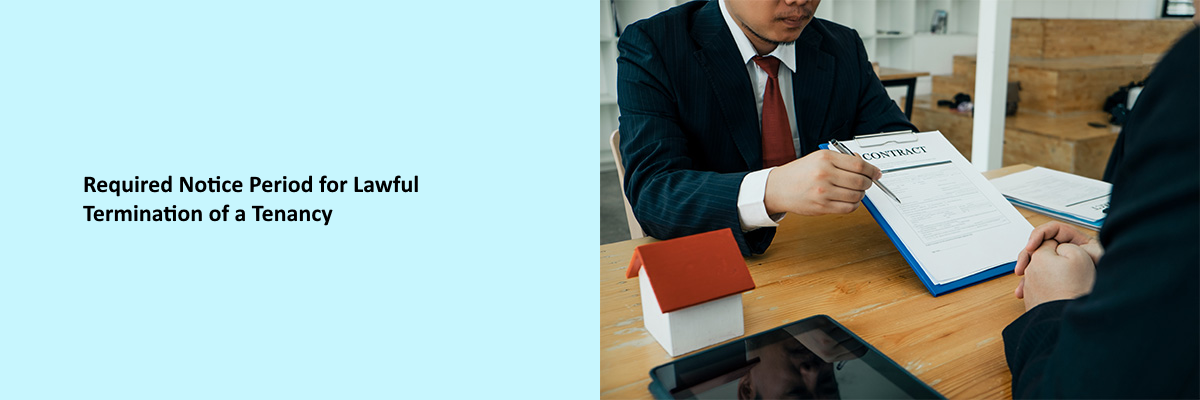When someone rents a property, whether it’s an affordable housing unit or a private rental, they typically sign a tenancy agreement. This contract outlines key details like rent amount, duration of tenancy, responsibilities of both parties, and what landlords or property managers can and cannot do. It also defines the tenant’s rights and obligations.
One important section in any tenancy agreement covers how the tenancy can end. This includes the termination process and the notice period required by law.
In this blog, we’ll break down the situations where a landlord can lawfully end a tenancy, the required notice period, and how that notice must be delivered to count as legal. We’ll also cover what happens if the tenant doesn’t see or acknowledge the notice, and how that impacts the termination process.



When Can a Landlord Legally End a Tenancy?
Landlords can’t just ask tenants to leave on a whim. There must be a valid reason that aligns with the lease agreement and relevant local or state rental laws. Here are common scenarios where a landlord or property manager may lawfully terminate a tenancy:
- The lease is ending and will not be renewed.
- The tenant refuses to accept a rent increase proposed by the landlord (in states where this is allowed).
- Non-payment of rent or consistent late payments.
- Breach of lease terms, such as unauthorized pets, occupants, or subletting.
- Property damage caused by the tenant beyond normal wear and tear.
- Illegal activity conducted on the premises.
- Owner move-in, where the landlord or their family intends to occupy the property (allowed in some jurisdictions).
- Renovations or demolitions that make the property uninhabitable during work.
- Conversion of use, such as changing a rental property into a commercial unit or selling it vacant.
Required Notice Period: How Much Time Is Legally Needed?
The notice period varies depending on several factors:
- Type of tenancy (fixed-term vs. month-to-month)
- Reason for termination
- State or territory laws
- What’s stated in the rental agreement
Examples of Standard Notice Periods:
- 30 Days: Common for ending month-to-month tenancies in many U.S. states.
- 60 Days: Required in some states when the tenant has been in the unit for over a year.
- 3 to 5 Days: Often applies to eviction notices for non-payment of rent or serious lease violations.
Important: Federal law rarely dictates notice periods for private rentals. These are governed by state and local laws, so landlords must check their local housing authority or state landlord-tenant laws to ensure compliance. In California, a 60-day notice is required for tenants who have lived in a unit for more than a year (Cal. Civ. Code § 1946.1).
If the lease agreement has its own notice terms, and they are stricter than local law, the landlord is typically required to follow those terms.
How Should Notice Be Given to Tenants?
To ensure the notice is legally enforceable, landlords must follow proper procedures for delivery. Accepted methods often include:
- In-person delivery to the tenant
- Posting the notice on the front door (in a clearly visible location) and mailing a copy
- Certified mail with return receipt
- Email or electronic delivery, only if allowed by the lease and state law
What to Avoid:
- Handing the notice to a neighbor or third party
- Slipping it under the door without confirmation
- Only mentioning it verbally
- Posting it in a shared area (e.g., mailbox cluster or community bulletin board)
These methods could render the notice invalid, potentially delaying or canceling the termination process.
What If the Tenant Didn’t See the Notice? Does It Still Count?
This is a common (and tricky) scenario. If the notice was delivered properly, it is usually considered legally valid, even if the tenant claims they never saw it.
The legal term here is “constructive notice,” meaning the tenant should have known because the landlord followed all correct procedures.
However, if the landlord didn’t deliver the notice using a legally acceptable method, the tenant’s claim could hold up, and the process may be reset.
That’s why proof of delivery matters, whether it’s a signature, timestamp, or photo of the notice being posted. Always document how and when you delivered the notice. That one step can save you weeks of legal delays.
Conclusion
Understanding notice periods isn’t just about counting days, it’s about complying with the law and protecting everyone’s rights. Whether you’re a landlord planning to reclaim your property or a tenant preparing to move out, clear communication and legal awareness are essential.
Before issuing any termination notice, check your state’s specific laws, review your lease agreement, and document everything. A properly delivered notice can prevent legal trouble, misunderstandings, and strained relationships.
And remember: just because you handed someone a piece of paper doesn’t mean the process is done. It’s your responsibility to ensure the notice is clear, legal, and documented. Want to ensure full compliance with fair housing laws? Explore our Fair Housing Webinars to stay informed and avoid costly mistakes.


